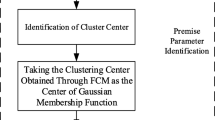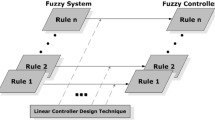Abstract
This work proposes an efficient and promising method for linear and nonlinear dynamic systems modeling. Unlike previous methods, we combine Fuzzy C-Means (FCM) and modified Particle Swarm Optimization (PSO) algorithms. The FCM allows clustering large nonlinear data sets (good rule-base parameters initialization). The PSO algorithm is used to optimize the parameters of the fuzzy system rules (initialized by FCM). This combination allows reducing the rule-base of TSK fuzzy model considering the three goals: have a good initialization of the parameters to be optimized, handling complex systems with ensuring a high accuracy and a low complex algorithm structure. Indeed, from a given fuzzy rule-base, FCM–PSO selects a subset of important fuzzy rules based on the threshold criterion of each rule. The interaction between the particles improves iteratively the quality of each fuzzy rule. Simulation results using two well-known benchmark functions show the efficiency of the proposed approach when compared to previous works.












Similar content being viewed by others
References
Abazari, A., Soleymani, M. M., Kamwa, I., Babaei, M., Ghafouri, M., Muyeen, S. M., & Foley, A. M. (2021). A reliable and cost-effective planning framework of rural area hybrid system considering intelligent weather forecasting. Energy Reports, 7, 5647–5666.
Aguilar, M. E. B., Coury, D. V., Machado, F. R., & Reginatto, R. (2021). Tuning of DFIG wind turbine controllers with voltage regulation subjected to electrical faults using a PSO algorithm. Journal of Control, Automation and Electrical Systems, 32(5), 1417–1428.
Al-Mohair, H. K., Mohamad, S. Junita., & Azmin, S. Shahrel. (2015). Hybrid human skin detection using neural network and K-means clustering technique. Applied Soft Computing, 33, 337–347.
Azar, A. T., Vaidyanathan, S. (2015). Computational intelligence applications in modeling and control. Springer.
Bagis, A., & Konar, M. (2016). Comparison of Sugeno and Mamdani fuzzy models optimized by artificial bee colony algorithm for nonlinear system modelling. Transactions of the Institute of Measurement and Control, 38(5), 579–592.
Bezdek, J. C., Ehrlich, R., & Full, W. (1984). FCM: The fuzzy c-means clustering algorithm. Computers and Geosciences, 10(2–3), 191–203.
Brikh, L., Guenounou, O., Yahiaoui, F., Kacimi, M.A. & Ouaret, A. (2016). Optimization of TSK fuzzy model using new improved PSO. International Journal of Control Theory and Applications, International Science Press, 323–333.
Cavuslu, M. A., Karakuzu, C., & Karakaya, F. M. (2012). Neural identification of dynamic systems on FPGA with improved PSO learning. Applied Soft Computing, 12(9), 2707–2718.
Eberhart, R., Kennedy, J. (1995) A new optimizer using particle swarm theory. In MHS’95. Proceedings of the Sixth International Symposium on Micro Machine and Human Science (pp. 39–43). IEEE.
Farag, W. A., Quintana, V. H., & Lambert-Torres, G. (1998). A genetic-based neuro-fuzzy approach for modeling and control of dynamical systems. IEEE Transactions on Neural Networks, 9(5), 756–767.
Ghomsheh, V. S., Shoorehdeli, M. A., & Teshnehlab, M. (2007). Training ANFIS structure with modified PSO algorithm. In 2007 Mediterranean conference on control and automation (pp. 1–6). IEEE.
Guenounou, O., Dahhou, B., & Chabour, F. (2015). TSK fuzzy model with minimal parameters. Applied Soft Computing, 30(3), 748–757.
Hilal, A., Boudjema, F., & Boukhetala, D. (2016). A multiobjective tuning approach of power system stabilizers using particle swarm optimization. Turkish Journal of Electrical Engineering and Computer Sciences, 24, 3898–3909.
Ishibuchi, H., & Yamamoto, T. (2005). Rule weight specification in fuzzy rule-based classification systems. IEEE Transactions on Fuzzy Systems, 15(4), 428–435.
Jang, J. S. R. (1993). ANFIS: adaptive-network-based fuzzy inference system. IEEE Transactions on Systems, Man, and Cybernetics, 23(3), 665–685.
Kacimi, M. A., Guenounou, O., Brikh, L., Haddid, N., & Yahiaoui, F. (2020). New mixed-coding PSO algorithm for a self-adaptive and automatic learning of Mamdani fuzzy rules. Engineering Applications of Artificial Intelligence, 89, 103–417.
Kahloul, A., & Anis, A. Sakly. (2020). Hybrid approach for constrained optimal control of nonlinear switched systems. Journal of Control, Automation and Electrical Systems, 31(4), 865–873.
Kanungo, D. P., Naik, B., Nayak, J., Baboo, S., & Behera, H. S. (2015). An improved PSO based back propagation learning-MLP (IPSO-BP-MLP) for classification. Computational Intelligence in Data Mining, 1, 333–344.
Karakuzu, C. (2017). On the performance of newsworthy meta-heuristic algorithms based on point of view fuzzy modelling. Turkish Journal of Electrical Engineering and Computer Sciences, 25(6), 4706–4721.
Kilic, H., Yuzgec, U., & Karakuzu, C. (2020). A novel improved antlion optimizer algorithm and its comparative performance. Neural Computing and Applications, 32(8), 3803–3824.
Li, W., Qiao, J., Zeng, X. J., & Du, S. (2020). Identification and simplification of TS fuzzy neural networks based on incremental structure learning and similarity analysis. Fuzzy Sets and Systems, 394, 65–86.
Li, C., Zhou, J., Chang, I., & Huang, Z. (2017). T–S fuzzy model identification with a novel hyper plane-shaped membership function. IEEE Transactions on Fuzzy Systems, 25(5), 1364–1370.
Mamdani, E. H., & Assilian, S. (1975). An experiment in linguistic synthesis with a fuzzy logic controller. International Journal of Man-Machine Studies, 7, 1–13.
Narendra, K. S., & Parthasarathy, K. (1990). Identification and control of dynamical systems using neural networks. IEEE Transactions on Neural Networks, 1(1), 4–27.
Nauck, D., & Kruse, R. (1998). How the learning of rule weights affects the interpretability of fuzzy systems, In 1998 IEEE international conference on fuzzy systems proceedings. IEEE world congress on computational intelligence (Cat. No. 98CH36228) (Vol. 2, pp. 1235–1240). IEEE.
Pedrycz, W., & Izakian, H. (2014). Cluster-centric fuzzy modeling. IEEE Transactions on Fuzzy Systems, 22(6), 1585–1597.
Pratama, M., Pedrycz, W., & Lughofer, E. (2018). Evolving, ensemble fuzzy classifier. IEEE Transactions on Fuzzy Systems, 26(5), 2552–2567.
Raheleh, J., Yu, W. (2017). Fuzzy modeling for uncertainty nonlinear systems with fuzzy equations. Mathematical Problems in Engineering
Spolaor, S., Nobile, M. S., Mauri, G., Cazzaniga, P., & Besozzi, D. (2019). Coupling mechanistic approaches and fuzzy logic to model and simulate complex systems. IEEE Transactions on Fuzzy Systems, 28(8), 1748–1759.
Sugeno, M., & Kang, G. T. (1988). Structure identification of fuzzy model. Fuzzy Sets and Systems, 28, 15–33.
Sugeno, M., & Tanaka, K. (1991). Successive identification of a fuzzy model and its applications to prediction of a complex system. Fuzzy Sets and Systems, 2(3), 315–334.
Takagi, T., & Sugeno, M. (1985). Fuzzy identification of systems and its applications to modeling and control. IEEE Transactions on Systems, Man, and Cybernetics, 1, 116–132.
Tong, R. M. (1979). The construction and evaluation of fuzzy models. In Advances in fuzzy set theory and applications (pp. 559–576). North-Holland.
Wang, L.-X., & Mendel, J. M. (1992) Back-propagation fuzzy system as nonlinear dynamic system identifiers. In 1992 Proceedings of international conference on fuzzy systems (pp. 1409–1418). IEEE.
Wang, L., & Langari, R. (1996). Complex systems modeling via fuzzy logic. IEEE Transactions on Systems, Man. and Cybernetics, Part B (Cybernetics), 26(1), 100–106.
Yen, J., & Wang, L. (1999). Simplifying fuzzy rule-based models using orthogonal transformation methods. IEEE Transactions on Systems, Man, and Cybernetics, Part B (Cybernetics), 29(1), 13–24.
Zenadji, S., Gueguen, C., Brikh, L., Talbi, L., & Khireddine, A. (2020). New strategy for resource allocation using PSO-PFS hybrid. International Journal of Wireless and Mobile Computing, 18(2), 175–182.
Author information
Authors and Affiliations
Corresponding author
Additional information
Publisher's Note
Springer Nature remains neutral with regard to jurisdictional claims in published maps and institutional affiliations.
Rights and permissions
Springer Nature or its licensor (e.g. a society or other partner) holds exclusive rights to this article under a publishing agreement with the author(s) or other rightsholder(s); author self-archiving of the accepted manuscript version of this article is solely governed by the terms of such publishing agreement and applicable law.
About this article
Cite this article
Brikh, L., Guenounou, O. & Bakir, T. Selection of Minimum Rules from a Fuzzy TSK Model Using a PSO–FCM Combination. J Control Autom Electr Syst 34, 384–393 (2023). https://doi.org/10.1007/s40313-022-00975-2
Received:
Revised:
Accepted:
Published:
Issue Date:
DOI: https://doi.org/10.1007/s40313-022-00975-2




